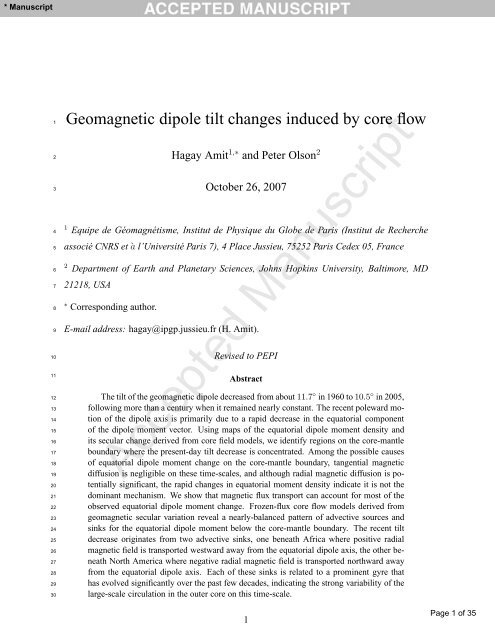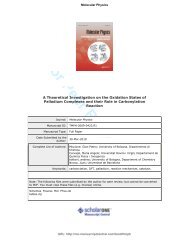Accepted Manuscript - TARA
Accepted Manuscript - TARA
Accepted Manuscript - TARA
Create successful ePaper yourself
Turn your PDF publications into a flip-book with our unique Google optimized e-Paper software.
* <strong>Manuscript</strong><br />
1<br />
2<br />
3<br />
4<br />
5<br />
6<br />
7<br />
8<br />
9<br />
10<br />
11<br />
12<br />
13<br />
14<br />
15<br />
16<br />
17<br />
18<br />
19<br />
20<br />
21<br />
22<br />
23<br />
24<br />
25<br />
26<br />
27<br />
28<br />
29<br />
30<br />
Geomagnetic dipole tilt changes induced by core flow<br />
Hagay Amit 1,∗ and Peter Olson 2<br />
October 26, 2007<br />
1 Equipe de Géomagnétisme, Institut de Physique du Globe de Paris (Institut de Recherche<br />
associé CNRS et à l’Université Paris 7), 4 Place Jussieu, 75252 Paris Cedex 05, France<br />
2 Department of Earth and Planetary Sciences, Johns Hopkins University, Baltimore, MD<br />
21218, USA<br />
∗ Corresponding author.<br />
E-mail address: hagay@ipgp.jussieu.fr (H. Amit).<br />
Revised to PEPI<br />
Abstract<br />
The tilt of the geomagnetic dipole decreased from about 11.7 ◦ in 1960 to 10.5 ◦ in 2005,<br />
following more than a century when it remained nearly constant. The recent poleward motion<br />
of the dipole axis is primarily due to a rapid decrease in the equatorial component<br />
of the dipole moment vector. Using maps of the equatorial dipole moment density and<br />
its secular change derived from core field models, we identify regions on the core-mantle<br />
boundary where the present-day tilt decrease is concentrated. Among the possible causes<br />
of equatorial dipole moment change on the core-mantle boundary, tangential magnetic<br />
diffusion is negligible on these time-scales, and although radial magnetic diffusion is potentially<br />
significant, the rapid changes in equatorial moment density indicate it is not the<br />
dominant mechanism. We show that magnetic flux transport can account for most of the<br />
observed equatorial dipole moment change. Frozen-flux core flow models derived from<br />
geomagnetic secular variation reveal a nearly-balanced pattern of advective sources and<br />
sinks for the equatorial dipole moment below the core-mantle boundary. The recent tilt<br />
decrease originates from two advective sinks, one beneath Africa where positive radial<br />
magnetic field is transported westward away from the equatorial dipole axis, the other beneath<br />
North America where negative radial magnetic field is transported northward away<br />
from the equatorial dipole axis. Each of these sinks is related to a prominent gyre that<br />
has evolved significantly over the past few decades, indicating the strong variability of the<br />
large-scale circulation in the outer core on this time-scale.<br />
<strong>Accepted</strong> <strong>Manuscript</strong><br />
1<br />
Page 1 of 35
















